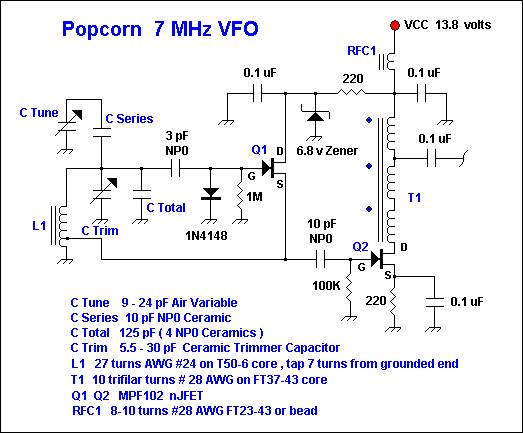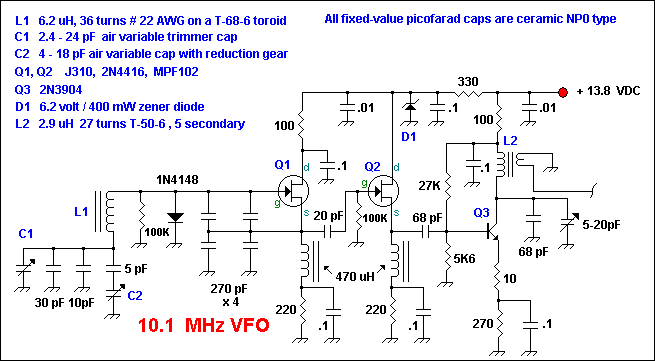![]()
It is unfortunate that some QRP operators are easy to spot on the amateur
radio bands. I have often encountered transmitted signals that suffer from chirp
and have poor short-term drift. Sometimes the operator is utilizing a
novelty-style rig and is excuseable, however some better quality rigs and even
commercial kit projects use VFO designs or building techniques which are not
optimal for emitting a stable, cleanly transmitted signal. The amateur radio
literature has extensively covered VFO design and construction practices making
poor VFO design/construction somewhat inexcusable in better quality radios. The
Clapp series-tuned has been described to have good short and long term drift so
I built one for 10.1 MHz and was pleasantly rewarded with a VFO that would be
suitable for a good quality 30 meter transmitter.

Figure 1
L1 was wound and then boiled in
water for ~5 minutes. It was glued to a single sided circuit board with
Polystyrene Q-Dope from GC Electronics. The coil does not lay on copper as I
used a motor tool to grind away the copper in the shape of a circle with a
diameter slightly larger than the wound coil. The inductor was doped face down
on this circuit and covered with 2 seperate coats. It is vital that your
inductor is secured so that it is unmovable!
The fixed capacitors in the
LC tank were NP0 ceramic types. Note that I used four capacitors for C Total to
aid in stability. I disconnected and measured C Trim and it read 18 pF.
Therefore with C Tune fully meshed, a total of 143 pF was required to resonate
the VFO at 7.40 MHz. The total capacitance is mentioned for ballpark reference
purpose only. It is unlikely to be a reproducable number. The main tuning cap
was purchased from Oak Hills Research years ago when they sold parts. It is a
very nice unit which features built in reduction gear and smooth action. I
coupled it to the inductor with C Trim to limit the tuning range of the variable
capacitor. With C Series at 10 pF as shown the tuning range was about 70 KHz. If
C Series was reduced to 5 pF, the tuning range was ~ 30 KHz. Perhaps a 7 pF cap
for C series would be a good compromise between the above mentioned caps as I
generally like my VFO's to swing around 50 KHz maximum.
The buffer amp
is not new, however the trifilar wound transformer for Q2 is a first for me.
This idea was borrowed from Rick Campbells binaural receiver project.( A
Binaural I-Q Receiver by Rick Campbell, KK7B for QST March 1999 ). This article
is a "must have". Hotter transistors for Q1 and Q2 may result in greater output
power and less popcorn factor. The Q2 source resistor may have to be increased
for a hotter JFET. See Rick's article schematic.
To increase the popcorn
factor of this VFO design, the air variable cap should probably be dropped and
replaced with tuning diodes. Some experiments using rectifier , varactor and
BJT's as tuning diodes were untaken in August 1999, however much more work is
warranted before any results can be posted to this web page. The best thing
about air variable caps for tuning is their uncompromising stability and
linearity.
10.1 MHz VFO Project

Tunes 10.1 - 10.165 MHz , 2 volts pk-pk into 50
ohms Discussion
Background
For the feedback capacitors, I used four of the
largest value NP0 ceramic that DigiKey sells; which are 270 pF. Reviewing the
amateur literature again revealed a huge variation in capacitance value versus
frequency for the feedback capacitors. I tried increasing the feedback
capacitance above the 270 pF paralleled values and could not measure any
improvement in short term frequency stability.
Design and Construction Information
Q2 and Q3 are lightly coupled to to minimize loading of the
previous stage. All leads on all components were cut short as practical. Note
that Q1 and Q2 are run at a lowered voltage to minimize component heating. I
hate duplicating the VFO tank capacitance values in other people's VFO designs.
You never seem to have the variable capacitors and some odd fixed-value caps
mentioned in their design. This VFO is no exception. For interest sake the total
capacitance of the various fixed value plus the trimmer capacitor to tune 10.1
MHz was just over 40 pF. This is with the main tuning capacitor fully meshed.
You will have to redesign the capacitor values to suit the components that you
have on hand. Do not use a cheap low-Q trimmer cap. I used a Johnson
air-variable unit in my design.
The main tuning cap was purchased from
Oak Hills Research years ago when they sold parts. It is a very nice unit which
features built in reduction gear and smooth action. I coupled it to the inductor
by a 5 pF NP0 capacitor to limit the tuning range of the variable capacitor. As
you can see, the VFO tunes up to 10.165 MHz, which is too much for 30 Meters. If
this VFO is used for exciting a transmitter on the air in the future, I will
further limit the tuning range to prevent inadvertant transmitting out of the 30
meter band limits.
This VFO was built for my test bench and has a built in 50
ohm -3dB attentuator for use with diode ring mixers as the output voltage is 10
dBm into 50 ohms. (not shown) The biggest drawback with the Clapp VFO in my
view, is that shifting the VFO for a frequency offset can be difficult at some
frequencies. Shifting this VFO 600 hertz off frequency for transmitting would
require a very very low capacitance change and would require some major
engineering. For this reason, I prefer not to use an offset on Clapp
designs.
The VFO was enclosed in a Hammond die-cast box to minimize
temperature changes and RF leakage. These Hammond cases. although expensive seem
to be great VFO enclosures from my experience. The VFO should be powered with a
well filtered DC supply.
The output of this VFO is a clean looking sine wave.
This is the most frequency stable VFO that I have ever built. I placed this VFO
near a commercial superhet receiver that has a 500 hertz wide crystal IF filter
and tuned the receiver so that the VFO signal (evaluated as an audio tone) was
centered perfectly in the passband. I heard a very stable 650 hertz audio tone.
One hour later, the audio tone was unchanged and the VFO was still centered in
the xtal filter passband. Listening to this VFO as an audio tone reminds one of
listening to a crystal oscillator. I evaluate all my oscillators this way as
variations in frequency are easily detected by variations in pitch by the
ultra-sensitive human ear.
The output tank on Q3 will require ~84 pF to
resonate and the 68 pF fixed value cap plus a 5 -20 pF trimmer tuned it well.
The turns ratio is 27:5 and I used AWG # 26 enamel covered wire. The output
impedance is close to 50 ohms. A low pass filter can be added for further signal
washing. The 470 microHenry RF chokes used on Q1 and Q2 were epoxy conformal
coated inductors that are color coded and resemble resistors somewhat. (DigiKey
M7845-ND)
Conclusion